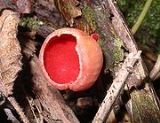
Ascomycota
Overview
The Ascomycota are a Division/Phylum
of the kingdom Fungi
, and subkingdom Dikarya
. Its members are commonly known as the Sac fungi. They are the largest phylum of Fungi, with over 64,000 species. The defining feature of this fungal group is the "ascus
" (from Greek
: (askos), meaning "sac" or "wineskin"), a microscopic sexual structure
in which nonmotile spore
s, called ascospore
s, are formed. However, some species
of the Ascomycota are asexual
, meaning that they do not have a sexual cycle and thus do not form asci or ascospores.
Phylum
In biology, a phylum The term was coined by Georges Cuvier from Greek φῦλον phylon, "race, stock," related to φυλή phyle, "tribe, clan." is a taxonomic rank below kingdom and above class. "Phylum" is equivalent to the botanical term division....
of the kingdom Fungi
Fungus
A fungus is a member of a large group of eukaryotic organisms that includes microorganisms such as yeasts and molds , as well as the more familiar mushrooms. These organisms are classified as a kingdom, Fungi, which is separate from plants, animals, and bacteria...
, and subkingdom Dikarya
Dikarya
Dikarya is a subkingdom of Fungi that includes the phyla Ascomycota and Basidiomycota, both of which in general produce dikaryons, may be filamentous or unicellular, but are always without flagella. The Dikarya are most of the so called "higher fungi", but also include many anamorphic species that...
. Its members are commonly known as the Sac fungi. They are the largest phylum of Fungi, with over 64,000 species. The defining feature of this fungal group is the "ascus
Ascus
An ascus is the sexual spore-bearing cell produced in ascomycete fungi. On average, asci normally contain eight ascospores, produced by a meiotic cell division followed, in most species, by a mitotic cell division. However, asci in some genera or species can number one , two, four, or multiples...
" (from Greek
Greek language
Greek is an independent branch of the Indo-European family of languages. Native to the southern Balkans, it has the longest documented history of any Indo-European language, spanning 34 centuries of written records. Its writing system has been the Greek alphabet for the majority of its history;...
: (askos), meaning "sac" or "wineskin"), a microscopic sexual structure
Sexual reproduction
Sexual reproduction is the creation of a new organism by combining the genetic material of two organisms. There are two main processes during sexual reproduction; they are: meiosis, involving the halving of the number of chromosomes; and fertilization, involving the fusion of two gametes and the...
in which nonmotile spore
Spore
In biology, a spore is a reproductive structure that is adapted for dispersal and surviving for extended periods of time in unfavorable conditions. Spores form part of the life cycles of many bacteria, plants, algae, fungi and some protozoa. According to scientist Dr...
s, called ascospore
Ascospore
An ascospore is a spore contained in an ascus or that was produced inside an ascus. This kind of spore is specific to fungi classified as ascomycetes ....
s, are formed. However, some species
Species
In biology, a species is one of the basic units of biological classification and a taxonomic rank. A species is often defined as a group of organisms capable of interbreeding and producing fertile offspring. While in many cases this definition is adequate, more precise or differing measures are...
of the Ascomycota are asexual
Teleomorph, anamorph and holomorph
The terms teleomorph, anamorph, and holomorph apply to portions of the life cycles of fungi in the phyla Ascomycota and Basidiomycota.*Teleomorph: the sexual reproductive stage , typically a fruiting body....
, meaning that they do not have a sexual cycle and thus do not form asci or ascospores.

